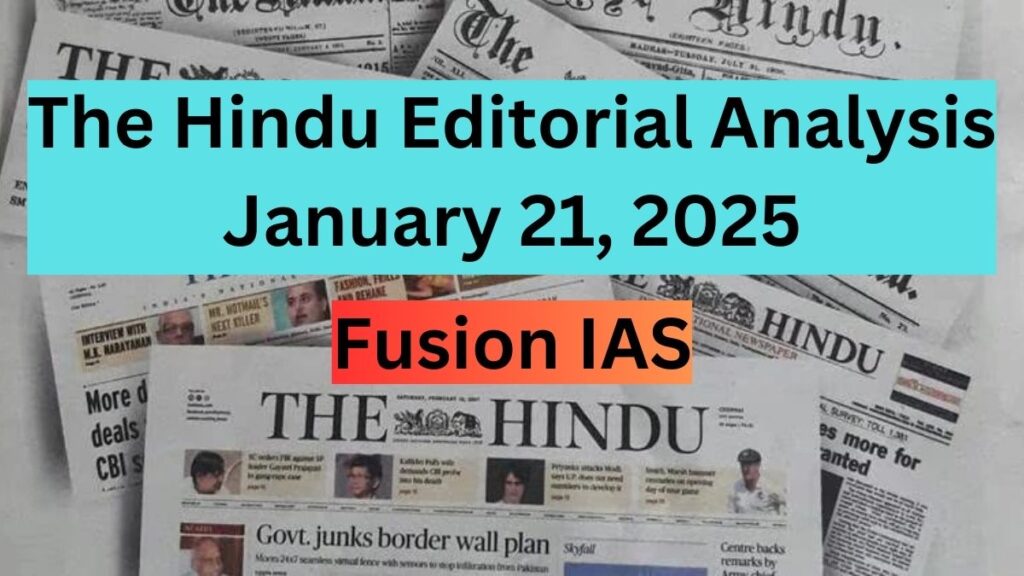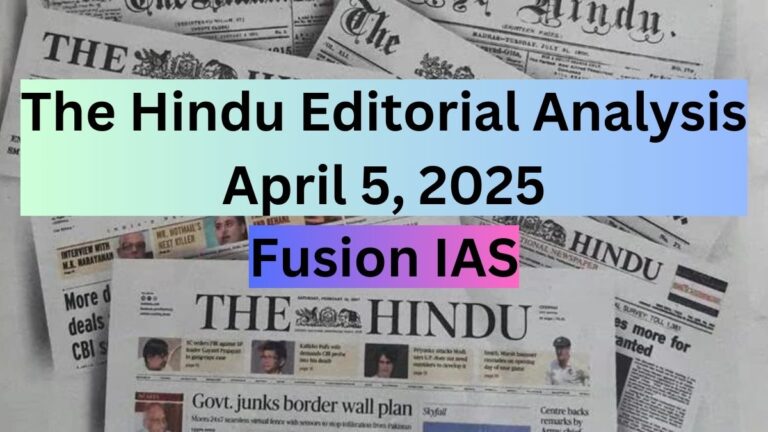
The Hindu editorials are a crucial resource for understanding key national and international issues. This analysis simplifies complex topics, highlights key points, and offers critical insights, making it an essential tool for competitive exam preparation like UPSC CSE and developing a well-rounded perspective on current affairs.
1. Prioritising IMEC is in America’s best interest
- Strategic Partnership Evolution:
- The U.S.-India relationship has grown into a vital strategic partnership, supported by bipartisan consensus since the 1990s.
- Key areas of convergence include economic growth, regional security, and democratic values.
- India-Middle East-Europe Economic Corridor (IMEC):
- Announced in 2023, IMEC aims to connect three regions through advanced physical and digital infrastructure.
- Objectives:
- Develop efficient transport networks (railways, shipping, maritime connections).
- Establish cross-border electricity, hydrogen pipelines, and digital communication cables.
- Enhance trade connectivity, reduce transportation costs, and diversify supply chains.
- Participating entities: India, U.S., UAE, Saudi Arabia, Italy, France, Germany, European Commission.
- Alternative to China’s Belt and Road Initiative (BRI):
- IMEC serves as a strategic alternative to BRI, promoting a balanced global economic architecture aligned with democratic and market principles.
- Benefits for India:
- Reduced trade costs.
- Resilience to disruptions (e.g., Suez Canal bottlenecks).
- Increased foreign direct investment (FDI).
- Strengthened ties with West Asian and European nations.
- Challenges:
- IMEC is currently more conceptual, requiring substantial planning and cooperation.
- Complexities include:
- High infrastructure investments competing with national priorities.
- Need for private sector engagement with clear return on investment pathways.
- Risk of uneven economic benefits causing political friction.
- International Efforts:
- France appointed a special envoy to lead the initiative.
- UAE and Saudi Arabia actively support the project to advance relations with the West.
- Regional players like Iraq and Türkiye are aligning trade agreements with IMEC.
- Environmental Implications:
- IMEC aligns with India’s focus on green hydrogen development.
- Potential to reduce carbon emissions, decrease fossil fuel dependence, and create jobs in green technologies.
- India collaborates with nations like Germany and Japan to advance green hydrogen infrastructure.
- Diplomatic Context:
- The Abraham Accords played a crucial role in enabling IMEC.
- U.S. leadership (e.g., Trump’s rapport with PM Modi) could shape IMEC’s future trajectory.
- Recent peace developments between Israel and Hamas could facilitate progress.
- Strategic Importance:
- IMEC symbolizes a reimagined model of regional economic cooperation.
- It necessitates unprecedented coordination among stakeholders, with the U.S. and India playing pivotal roles.
2. Go, kho kho, go: On boosting sport with a rural heart
The article discusses the need to focus on boosting rural sports like Kho Kho and improving India’s overall sports infrastructure. Here are the key points:
- Lack of Popularity in Kho Kho: Despite Kho Kho’s historical origins in India, it remains an underdeveloped and underappreciated sport both globally and nationally. India won both men’s and women’s titles at the inaugural Kho Kho World Cup, but it still hasn’t gained significant global attention.
- India’s Performance in Global Sports: India struggles to be a major power in global sports, with cricket and chess as exceptions. However, even in these sports, India’s achievements have not been adequately recognized or supported, particularly in non-cricket disciplines.
- Government Support for Sports: There is a need for greater government support to raise the profile of sports like Kho Kho, chess, and other Olympic disciplines. India’s performance at the Paris Olympics (2024) highlighted the gap in India’s sporting achievements, with no gold medals and a disappointing overall ranking.
- Sports Federations and Infrastructure: Indian sports federations need to review their functioning. Lessons could be drawn from the Board of Control for Cricket in India (BCCI), which has improved infrastructure, and shared revenue growth with players. This model could be applied to other sports to ensure sustainable growth.
- Expansion Beyond Cricket: While India is a cricket-centric country, there is potential for other sports, like kabaddi, which have gained popularity with leagues like the Pro Kabaddi League. This demonstrates that other sports can thrive on television and attract viewership.
- Khelo India Scheme: The effectiveness of the Khelo India initiative, which has a significant budget allocation, should be evaluated. The government needs to assess whether the program is truly helping in the development of sports at the grassroots level.
- Infrastructure Development: Both central and state governments need to improve sports infrastructure to nurture a broader range of sports, particularly those with rural roots, like Kho Kho, kabaddi, and others.
3. UGC’s draft regulation has serious constitutional issues
The article addresses the constitutional issues surrounding the University Grants Commission’s (UGC) draft regulation on the selection and appointment of university vice chancellors. Below are the key points:
- Context of UGC’s Regulation: The UGC proposes to amend Regulation 2010 to widen the criteria for selecting vice chancellors, including professionals with 10+ years of experience in industry, public administration, or public policy. This is opposed by non-BJP state governments, citing concerns about federalism and constitutional violations.
- Constitutional Concerns: The UGC Act, 1956, mandates the UGC to coordinate and set standards in university education, but does not include the regulation of vice chancellor appointments. Critics argue that the UGC does not have the authority to prescribe qualifications or selection processes for vice chancellors, as this is a matter for state legislation.
- Scope of UGC Act: Section 26 of the UGC Act grants the UGC the power to make regulations for promoting university education and maintaining standards. However, the appointment of vice chancellors is not related to educational standards. Thus, regulating vice chancellors goes beyond the UGC’s legislative mandate, which is limited to areas like teaching standards and qualifications of teaching staff.
- Judicial Precedents:
- Suresh Patilkhede Case (2011): The Bombay High Court held that the qualifications and selection methods of vice chancellors do not directly affect educational standards.
- Kalyani Mathivanan Case (2015): The Supreme Court ruled that UGC regulations have binding effect, even on state universities. However, it also emphasized that these regulations must respect state legislation.
- Constitutional and Legal Questions:
- The key issue is whether UGC regulations can override state laws. Under Article 254 of the Constitution, a central law can override a state law if there is repugnancy. However, subordinate legislation like UGC regulations is not considered a “central law” in this context, thus complicating the legal status of UGC’s regulations.
- Conclusion: The article highlights the constitutional and legal complexities of the UGC’s proposed regulation, questioning whether the UGC has the authority to regulate vice chancellor appointments, which traditionally fall under state jurisdiction. This issue of federalism and the separation of powers between state and central authorities is crucial for understanding the broader implications of the regulation.
Disclaimer:
This analysis is based on the editorial content published in The Hindu and is intended solely for informational and educational purposes. The views, opinions, and interpretations expressed herein are those of the author of original article. Readers are encouraged to refer to the original article for complete context and to exercise their own judgment while interpreting the analysis. The analysis does not constitute professional advice or endorsement of any political, economic, or social perspective.
Follow Fusion IAS


